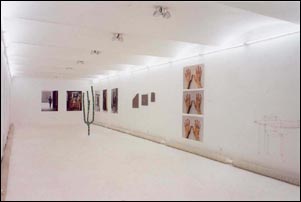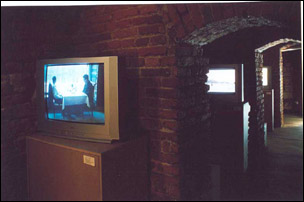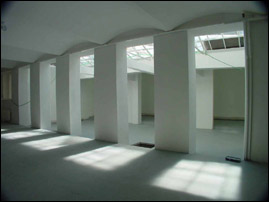FUTURA, Prague (“Series Young Galleries in Eastern Europe”)
This is the first in a series of essays in which we will introduce new gallery ventures in East-Central Europe. We want to give young gallerists a chance to introduce their spaces and the economic and institutional challenges they face. acb contemporary art gallery in Budapest works on a commercial basis; its goal is to generate revenue by selling contemporary visual artworks. Information, resumes, documentation, and mission statement are available at www.acbgaleria.hu (Slide Show).
We, a group of young international art organizers living in Prague, the Czech Republic, over the last ten years, finally met each other in November 2002 and discovered that we all had the same dreams and goals in mind.
With dwindling public and state funding for the fine arts, the withdrawal of The Soros Center, and long established art spaces closing down from month to month, it was clear Prague was getting itself into a cultural crisis.
We found an essential need in Prague to provide both the local public and an increasing number of international visitors with the opportunity to meet one another in a common, easily accessible forum.
We envisioned a stable art space with a clear vision, one that had a real future.
We imagined a single institution that could link the broader public with contemporary fine art, and facilitate a more fluid dialogue within the various fields of fine art and culture.
Founded in June 2003 by Marisa Ravalli-Prihodova (head member) and Alberto di Stefano, Camille Hunt, and Eugenio Percossi, FUTURA (Centre for Contemporary Art+Events) came into existence.
FUTURA (named after a famous Italian song) became a non-profit centre focused on the exhibition and promotion of both international and local contemporary fine arts and events.
With the various small commercial galleries already apparent throughout the city, mostly exhibiting and selling Russian Avante-Garde and Ukranian works, and with the controversial situation of the local state National Gallery, we felt what was really missing was a non-profit arts institution.
The three-floor building (formerly a factory) was reconstructed within a matter of three months into a combination of “white-cube” exhibition halls and a series of cellar-style spaces, that now host a wide variety of visual art including photography, painting, installation, sculpture, and new media.
Located in the emerging district of Prague 5 just ten minutes from the city centre, it has over eight hundred square metres of exhibition space, making it one of the largest, major, independent art institutions in the Czech Republic.
It is a place where multidisciplinary art is welcomed and supported, and offers sufficient space for a variety of art activities and events.
FUTURA strives to become a vital partner within the larger visual art community, and eagerly seeks cooperation with galleries, institutions, and artists from other countries.
Another goal of FUTURA’s activities is to provide opportunities for exchanges and cooperation between artists and art institutions both locally and internationally, which will inevitably lead to a new and diverse viewing audience, strengthening ties between the Czech Republic and beyond.
The current Prague art and cultural scene had lacked this kind of amiable space, one that welcomed the influx of influences from abroad.
We believe that contemporary art, as a unique universal “language,” can make a significant contribution to the discussion and understanding between various peoples and cultures.
FUTURA’s program attempts to mix artists from different countries throughout its spaces, while tying the exhibitions together via common themes in the works.
FUTURA opened its exhibition program with a large group exhibition titled SURVEY 03’. It featured works by over twenty established and emerging Czech contemporary artists.
Spanning various generations and artistic mediums, SURVEY 03’ gave a decisive overview of current practices in Czech art (curated by FUTURA and Karel Cisar).
The exhibition also included the unveiling of the first specially commissioned artwork by an artist for FUTURA.
David Cerny, known for his various confrontational public art works, exhibited locally and internationally, enthusiastically agreed to become involved with FUTURA and the commission.
This new sculptural work provoked vast public interest and controversy as it included a video inside the ass of two giant figural sculptures depicting two men wearing rubber masks—one of the President of the Czech Republic, Vaclav Klaus, and the other of artist and head of the National Gallery in Prague, Milan Knizak.
The two men feed each other in slow motion a white opaque soup to the song “We Are the Champions,” by Queen.
The exhibition as a whole included video works by Zbynek Baladran, Ondrej Brody, Alena Kotzmannova, Frantisek Kowolowski, Michal Pechoucek and Marek Ther.
Paintings and photos included works by Veronika Bromova, Tomas Lahoda, Jan Merta, Petr Nikl, Robert Novak, Jasansky/Polak, Mila Presslova, and Jan Serych, and object and installation works by Kristof Kintera, Jan Kotik, Jan Mancuska, Frantisek Scala, and Katerina Vincourova
Our second exhibition featured two solo-exhibitions. Annika Larsson (born in Sweden) presented her award-winning video works for the first time in the Czech Republic titled “Dog“ and “Poliisi.”
Using the camera as a microscope and mirror through her use of sharp close-ups and repeated sequences, she exposes the allure and ugliness of power and success within a male-dominted society.
Both videos also weave a filmic tapestry of dominance and submission, Fascism and alienation, all tied up with hypnotic music soundtracks composed by artist Tobias Bernstrup.
Every image in Annika Larsson’s videos is carefully constructed and intentional.
Larsson also shoots, directs and edits all her videos herself. With richly conceived, erotic-laden narratives, she draws the viewer into her dubious worlds of masculinity—an uncertain place where power, control, and lack of communication disturbingly become the norm.
The new series of paintings entitled entitled Sober-minded by Jiri David, who was born in the Czech republic, premiered for the first time at FUTURA.
Each painting amazingly blends various styles and trends in contemporary painting over the last four decades onto a single canvas.
Through techniques of montaging, overlapping, and layering the different styles, David has created a kind of synthesis of the genres into a painted “network” for the new millennium.
His technique is mostly precise and detailed, so that at a first glance the images appear as computer graphic or print.
Indeed, the images for each painting were initially created in computer programs.
Yet on other paintings, brushstrokes are made more apparent, bringing the viewer back into the reality of the classic medium he chose to use—acrylic and oil on canvas.
The rather humorous title of this vast, abstract series (over seventy paintings so far) points to 1960’s and 1970’s psychedelia, but also to more contemporary tendencies toward abstinence and self-control.
Although a certain amount of self-control was necessary in the creation of this new series of paintings, it is Jiri David’s wild imagination that makes these works so hypnotic and memorable.
The third exhibition at FUTURA was a group exhibition of the Finalists of the Jindrich Chalupecky Award (the Czech version of the Turner Prize).
It featured a specially commissioned work by each artist. The finalists were Jan Serych, Michaela Thelenova, Michal Pechoucek, Jan Mancuska, and Kristof Kintera.
The Jindrich Chalupecky Award is the most prestigious prize given to an artist under the age of thirty-five, and is held under the auspices of former President to the Czech Republic, Vaclav Havel.
Vaclav Havel graced the halls of FUTURA and presented the prize to the winner, Michael Pechoucek for his video work “The Secret of the Chain Letter”, 2003.
The current exhibition presents twelve young video artists from across Italy curated by Paola Capata, a solo-exhibition of photo and installation works by Federico Pietrella, and a solo-exhibition of new photographs by Veronika Bromova titled “My Files.”
FUTURA’s event programme is just getting off the ground. So far it has held informal public group discussions with artists, workshops with children from local schools, workshops with minority children, and has hosted artist group presentations.
It is currently planning an evening of animated film showings and live music events throughout the year as well.
This programme works as an open door to artists passing through the city, to more renowned performers and writers.
We are also in the process of starting an on-site Café and Art Bookshop, which should be open by the end of Summer 2004.
Another important part of our activites is our collaborations with The Castle Trebesice Artists-in-Residence Programme, which held its first session in Summer 2003 and will be held every summer in collaboration with the board of FUTURA.
It organises exhibitions, festivals and meetings as moments of opening its doors to the more local public—as moments of reflection and synthesis.
The programme itself is open to selected local and international artists, and encourages exchange projects and meetings with artists and friends of art, and aspires to involve other arts organizations linked by common projects.
The Castle hosts visitors from different cultures directly and/or in cooperation with arts and cultural bodies and institutions.
Through direct private commissions and in cooperation with outside funding and sponsors, the project provides the means and setting to facilitate the creation of various types of fine art.
Four floors of a large Baroque granary will also host the FUTURA Collection that will be perpetually acquired and publically displayed.
The large vaulted premises of the old stables will host studios, workrooms, and summer workshops.
Other agricultural structures, including a huge hay loft (the largest in Central Europe), and outside garden and field areas are also available as both temporary and permanent exhibition areas.
Annual festivals and shows will offer a periodic opportunity to open the doors of this small community to the wider public as well.
Although FUTURA is only in its beginning stages, it has already gained much interest and attention.
We have been invited to present our space and some of the artists whom we have worked at The Armory Show this March 2004 in New York, and are planning more international and Czech exhibitions throughout the upcoming year.
In a time when art institutions and galleries are charging higher and higher entrance fees, FUTURA remains free of charge and provides a space for children and vistors of all ages.
We feel FUTURA is unique in that it overcame the obstacles of low state and public funding by seeking out on its own, grants and private sponsors in order to make its activites a reality.
In a time of economic and societal depression, FUTURA acts as an inspiration for other arts and cultural initiatives in Central and Eastern Europe, and is living proof that dreams really can become a reality—especially when done through mutual collaboration, tolerance, and understanding.
FUTURA
Holeckova 49
150 00, Prague 5
Czech Republic
tel. +420 251 511 804, info@futuraprojekt.com, www.futuraprojekt.com
Other essays in this series:











